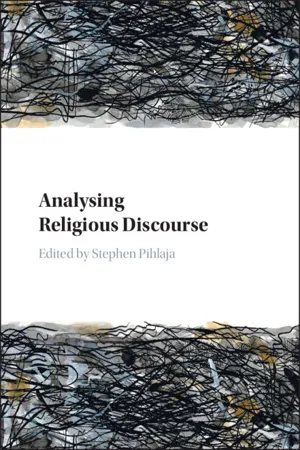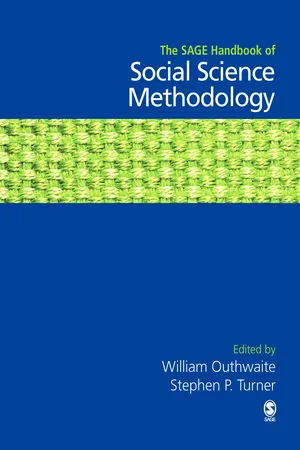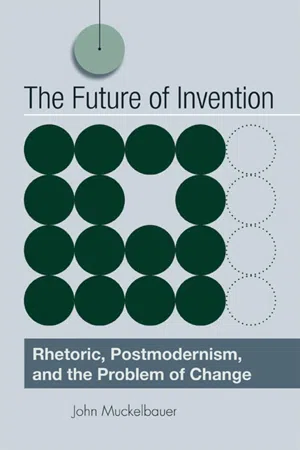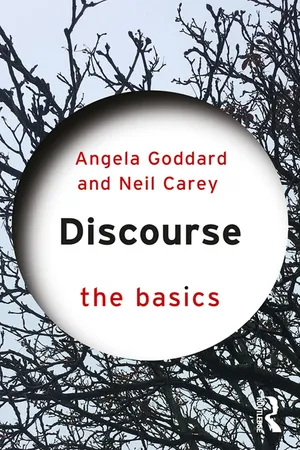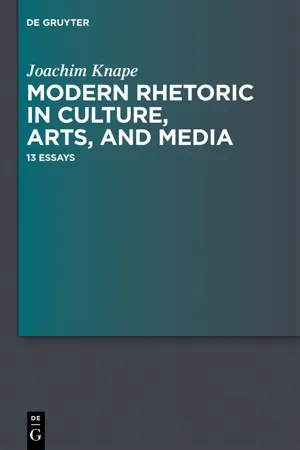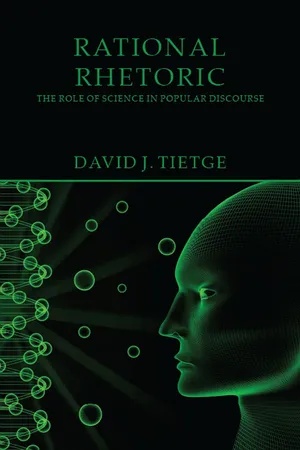Languages & Linguistics
Induction Rhetoric
Induction rhetoric refers to a persuasive technique that aims to influence an audience by using examples and specific instances to draw general conclusions. It involves presenting specific cases to support a broader claim, often appealing to the audience's emotions and experiences. This rhetorical strategy is commonly used in persuasive writing and speech to build a compelling argument based on specific instances.
Written by Perlego with AI-assistance
Related key terms
1 of 5
6 Key excerpts on "Induction Rhetoric"
- eBook - PDF
- Stephen Pihlaja(Author)
- 2021(Publication Date)
- Cambridge University Press(Publisher)
Indeed, rhetoric is a process of invention whereby rhetors seek out arguments crafted to persuade particular individuals and groups. Rhetoric has historically tried to track and trace ‘forms’ and types of argu- ments. Classical rhetoric organised arguments into basic forms: judicial, delib- erative, and epideictic. Judicial or forensic rhetoric involves arguments exploring whether a wrong has been committed as in a courtroom trial. Deliberative rhetoric involves arguments about what to do under certain cir- cumstances, as in a legislature where representatives argue about whether or 92 Beau Pihlaja how to best craft a law. Epideictic rhetoric refers to speech in which one might praise a person or group as in a eulogy or, conversely, heap scorn and blame on a person or group as in a ‘jeremiad’, a religious screed against a nation’ s purported sins. In global Christian circles especially, an expansive sub-genre of education and practice (‘apologetics’) circulates around making and learning to make defensive arguments (apologia) for beliefs and actions in various situations. Apologetics is not limited to Western Christian practice, however. Every religion has some form of outreach practice intended to either persuade others to join it or at the very least ‘bear witness’ to the faith’ s essential truths and practices. Islamic dawah has also developed both in dialogue with, and counter to, ongoing proselytising efforts of Christians. In the new era of social-media driven circulation of ideas and arguments, new forms of apologia proliferate; for example, atheists make increasingly visible arguments against a belief in any deity (see, especially, S. Pihlaja, 2018). Consequently, apologetics are an important rhetorical form for those studying religious language use. - William Outhwaite, Stephen Turner, William Outhwaite, Stephen Turner(Authors)
- 2007(Publication Date)
- SAGE Publications Ltd(Publisher)
In effect, rhetoric offers an extended demonstration of how sense-making between people is carried out. RHETORICS OF SOCIAL SCIENCE: SOCIALITY IN WRITING AND INQUIRY 481 DISCOURSE CONSTRUCTION PART 1: ARGUERS AND AUDIENCES IN THE RHETORICAL ANALYSIS OF ARGUING An unparalleled impetus to observing major flows among interblended currents of argu-ment remains Aristotle’s Rhetoric . This observation is not intended to endorse a ‘his-torical’ approach to the subject; rather, it sup-ports an approach to language which stresses its use by human agents in reasonable argu-mentation. Aristotle distinguishes between currents associated with author, audience and argument, and shows how they contribute to inference itself, via rhetorical (enthymematic) deduction and induction (Edmondson, 1984; Woerner, 1990). These are not intended as the sole analytical instruments offered by a rhetorical approach to social-scientific argu-ing (cf. Atkinson, 1990: 25). During the twentieth century, as Vickers (1988) com-plains (cf. Burke, 1945), attempts were made to reduce rhetoric’s conceptual armory to small numbers, usually featuring metaphor and one or two others. In contrast, the Aristotelian distinctions do not obliterate other rhetorical patterns, but clarify the argu-mentative streams into which they fit. They expose arguments’ phenomenological struc-tures, guiding our perception of roles played within them by styles such as realism, or by tropes (terms substituting for or transforming conventional meanings) such as metonymy, synecdoche or metaphor. This phenomenology of argument is both diagnostic and prescriptive. It shows how we argue as a matter of fact, and how to do it better. This diagnosis also stresses the con-stant interaction between major components of arguing. The ‘argument itself’, ‘logos’, is always informed by its social situatedness, for arguments are made by people to people.- eBook - PDF
The Future of Invention
Rhetoric, Postmodernism, and the Problem of Change
- John Muckelbauer(Author)
- 2009(Publication Date)
- SUNY Press(Publisher)
Though rhetoric may be essential to the persuasive transmission of the proposition and to the various political, juridical, and ethical functions that such persuasion serves, it is not relevant to the emergence of the proposition in the first place. In this conventional diagram, one does not discover the proposition through rhetoric; one merely invents the contingent and contextual means for provoking effects through it. As the art of persuasion, rhetoric is distinct from the arts of discovery. 4 Of course, persuasion does require some kind of discovery—one must discover the most effective arguments and proofs for transmitting a proposition. But this discovery is merely the discovery of contingent and contextual strategies. It is something quite different from the dis- covery of the proposition itself, a process that is not subject to the forces of contingency and context. As Porter explains, “The rhetorician Why Rhetoric? Which Rhetoric? 19 considers variability in audience disposition; the dialectician (who goes by various names—philosopher, logician, scientist) does not need to” (18). In short, while rhetorical invention is a necessary and integral step for persuasively transmitting the proposition in a particular situation, it is irrelevant to the actual discovery of the proposition. Perhaps it is understandable that, thirty years ago, the Committee on the Nature of Rhetorical Invention would not be content with this conventional diagram, one in which rhetoric is subservient not only to the proposition, but also to the other modes of inquiry through which the proposition emerges. In any case, they explicitly recommended that the scope of rhetorical inquiry be expanded to include what they called a “generative theory of rhetoric” (Scott, 230). According to the commit- tee, this generative rhetoric would offer a sense of invention that was not confined solely to the discovery of persuasive strategies for proposi- tions arrived at by other means. - eBook - PDF
- Angela Goddard, Neil Carey(Authors)
- 2017(Publication Date)
- Routledge(Publisher)
As more and more organ- isations use social media and digital tools themselves, the idea of 72 DISCOURSE AND RHETORIC individuals communicating their personal experiences can become part of an organisation’s rhetorical strategy. For example, the UCAS site referred to previously features student bloggers, with a blogger named each month as ‘blogger of the month’. It would be a crude oversimplification to describe all the exam- ples mentioned so far – from political speeches and statements to interpersonal communication, with the commodified social media posts somewhere in between – as simply forms of ‘lying’. But each act of promotion, whether corporate promotion or self-promotion, is a rhetorical activity, designed to position the speaker or writer in a certain way, and to establish a relationship with the listener or reader – in other words, to create a sense of mutual reality. Such shared understandings, between the producers and consumers of written or spoken texts, are created through the use and inter- pretation of particular linguistic conventions that reference shared knowledge of wider cultural discourses. Rhetorical techniques and skills can equally be seen in an entirely positive light. Instead of seeing them, as critics of rhetoric may do, as a matter of style over substance, they can be viewed as represent- ing a powerful way to communicate a genuinely heartfelt message. If you really believe in something then of course you would like to convince others of the value of your perspective. What better way to do that than to think carefully beforehand about the best possible way to convey your convictions? Toye (2013) comments that if you were forced to defend your innocence in a courtroom, you would want your lawyer to make a passionate plea to the jury on your behalf, rather than simply rehearsing a list of facts. - eBook - PDF
- Joachim Knape, Alan L. Fortuna(Authors)
- 2012(Publication Date)
- De Gruyter(Publisher)
that during the course of the communication, one or the other speaker is trying to impose his own point of view or his own intentions through the use of persuasive speech. In short, my observation focuses on the rhetorical factor in communi- cation. This factor is the phenomena of persuasion, with all its implications. Thus, I am not simply interested in the question of how they communicate on the island in general: how their language is ordered, how it works, what kinds of texts are exchanged, what is narrated etc. On the contrary, I look at the matter from a very specific angle, namely: what are the conditions of successful communication on this island? That is the rhetorical question.” Lévi-Strauss isn’t satisfied with this answer, “although this is a clearly directed question, the phenomena you want to analyze go far beyond what Herr Lausberg has just presented to us as ‘rhetoric’.” 41 Jacobs 2002, p. 213. 88 Language or Rhetoric? A Dialog “You’re right,” I reply. “Herr Lausberg concentrates entirely on the internal set of rules and regulations that have been established over a period of two- and-a-half-thousand years for the composition of rhetorically overcoded texts. He represents a tradition which views rhetoric as an art of speaking well, an ars bene dicendi. These rhetoricians devote their attention to the linguistic and non-linguistic overcodes that have arisen over the course of history. They are regularities that join with the grammatical regularities in the construction of a text. The grammarian is interested in convenient and correct sentences. The intrinsic rhetorician is interested in overcodes, in forms like parallelism or chi- asmus, which you can build on top of the grammatical foundation, and which promise some kind of specific effect. This intrinsic perspective is of course very limited, despite the fact that it stems from a long-standing tradition.” “That is why I called my book the ‘Handbook of Literary Rhetoric’,” Laus- berg interjects. - eBook - PDF
Rational Rhetoric
The Role of Science in Popular Discourse
- David J. Tietge(Author)
- 2008(Publication Date)
- Parlor Press, LLC(Publisher)
It Introduction: A Case For Rhetorical Studies 15 is unusual for anyone outside of rhetorical studies, philosophy, liter-ary criticism, or communication theory to question how it is that the language students encounter has meaning. On the undergraduate level, the search for meaning is rarely addressed, even in above-cited areas of inquiry. Graduate students in these fields are the only ones likely to ever encounter questions about issues like authorial intent and author-ity, the rhetorical efficaciousness of language acts, or how a text gen-erates meaning for one audience but not another. Rhetorical studies sees these questions as fundamental; it is impossible to be thoroughly educated without at least a working understanding of how language means. Otherwise, education devolves into training, and training is a poor substitute for the fuller, richer educational experience that—all unsubstantiated nostalgia aside—once was the standard in a humanis-tic higher education. Rhetoric offers students an opportunity to delve deeply into our most important human resource, language, in order to get a better idea of how and why it is that humans respond to the insti-tutional symbolism that defines who we are and what we think. Outside of linguistics, there is no science for such a project. Even linguistics, while useful for understanding the structure and technical dimensions of language, is not systematically equipped to deal with the more philosophical questions that give language meaning. Rhetoric, however, is a discipline specifically suited for this purpose. Through it, students can learn not only what something can possibly mean, but how it achieves that meaning. Rhetoric becomes one of the most serviceable of the meta-disciplines because it must generate a way of talking about language by using language. It differs from a more scien-tific approach, however, in that it doesn’t assume to be above the very rhetorical operations it purports to describe.
Index pages curate the most relevant extracts from our library of academic textbooks. They’ve been created using an in-house natural language model (NLM), each adding context and meaning to key research topics.
